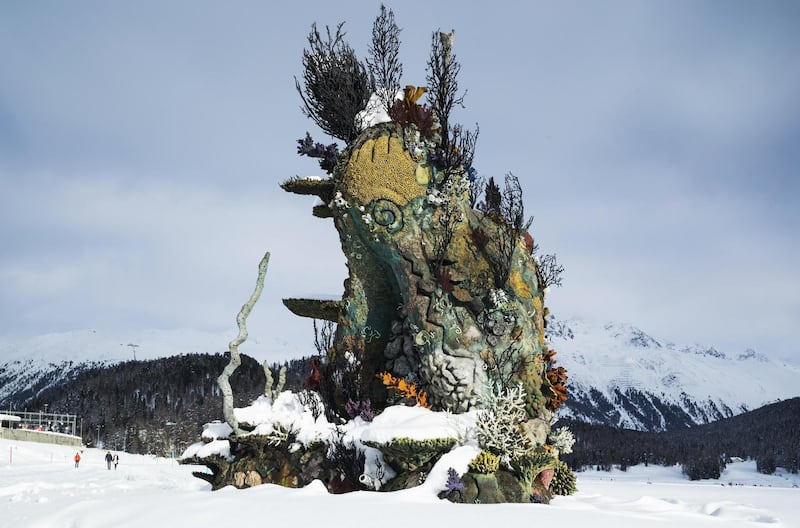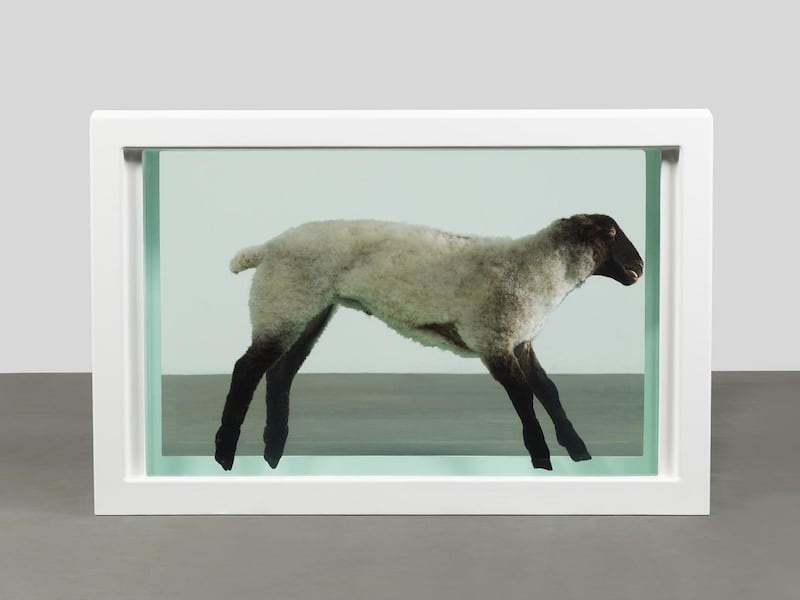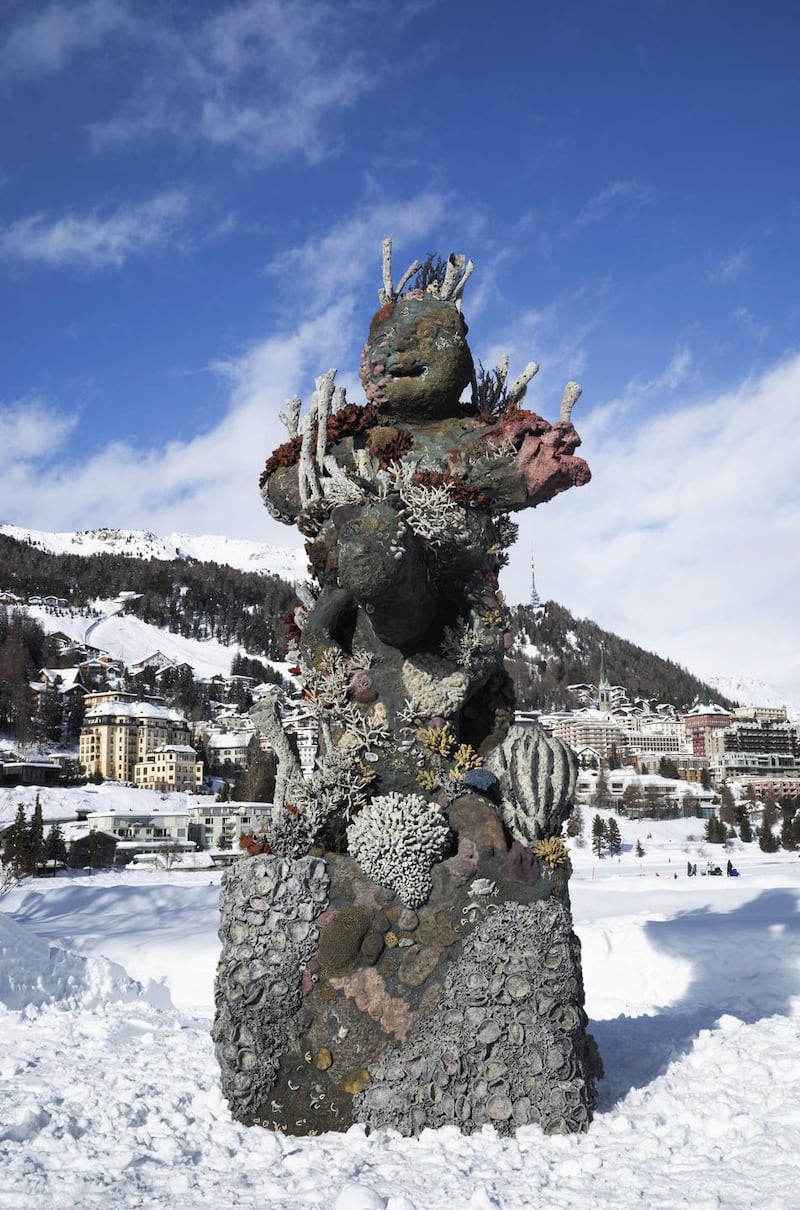If anyone should have been ready for this it was Damien Hirst. Thirty years before the pandemic that has made the modern world feel mortal, a young artist from England was putting dead animals in glass tanks and arranging drugs in medicine cabinets to ram home the fragility of life.
Now Hirst is in lockdown like all of us, and as he chats via Zoom from what must be the least impressive room in his house, a small, spartan space with a blue and white cloth over a tiny window, he agrees that that early work suddenly feels very current.
My early work is on a knife-edge between life and death. And that's how it feels now. It's a hopeless thing if you're not careful: the Covid crisis, Brexit. It can make you get into a hopeless place
“It’s a knife-edge between life and death. And that’s how it feels now. It’s a hopeless thing if you’re not careful: the Covid crisis, Brexit. It can make you get into a hopeless place. I’m worried about my mum: she’s in Devon, isolating. Worried about my kids.”
At least he's had a nice big lockdown project to distract him. A spectacular survey of his art is on in St Moritz, in Switzerland, that he orchestrated entirely by social media and phone. The image that holds me most is a towering painted statue of a man with his skin peeled off to reveal the internal organs – bright-blue aorta, red-veined heart, brown liver, sausage-like intestines – all framed against the blue sky and white mountains of an Alpine vista. He appears buried up to his loins in crisp clean snow. I'd love to be there in person, dwarfed by this 7m-tall colossus called Temple, one of the variations on the theme of human dissection that started with his statue Hymn (1999-2005). But I can only explore Hirst's Swiss show on my screen. And Hirst is in the same boat.

In fact, he says, “I’ve never been to St Moritz. But I know where everything is there. It’s like when I used to play Tomb Raider in the early days, and I went into a square in Venice and recognised it from the video game.”
Not for nothing is the show titled Mental Escapology. Hirst had fun directing its creation over FaceTime, obsessing over heights and placings of exhibits in the town’s Protestant church and watching anxiously as the crew struggled to install a seaweed-sprouting giant called The Monk in the middle of a lake before it froze.
I was mildly surprised when Hirst’s PR got in touch to offer me an interview. I have been very rude about him on occasion: I once wrote that his paintings resemble the art of a dictator surrounded by lackeys who are too scared to tell him he’s talentless.
Hirst thought about getting a male and a female corpse, cutting them in half and fitting them together with his penis inside her, to re-create a drawing by Leonardo da Vinci
But the truth is I’m a fan who gets cross when he fails to live up to my expectations. When I first saw his shark swim towards me at the Saatchi Gallery, in London, it was like nothing I had ever seen – it bit into my soul. It’s nice in the strange intimacy of Zoom to be able to tell him the truth, that when my own mother was having heart surgery in the 1990s I wandered the hospital seeing his vitrines in my head. Today I still think he’s a great sculptor, even if he’s a lousy painter.
I ask Hirst a question I have always wanted to put to him. Why did he never move on from putting animals in formaldehyde to pickling people?
“I flirted with the idea,” he says. He thought about getting a male and a female corpse, cutting them in half and fitting them together with his penis inside her – “like the Leonardo da Vinci drawing!” I say. It’s true – he intended to re-create a drawing by Leonardo that opens up a man and woman to show the anatomy of copulation.
But Hirst never did work with human bodies. “I much prefer it when you’ve got this neglected thing like a sheep, which is meat – you’re thinking, Why am I feeling empathy? That’s a great thing, because you should. Because it’s not just meat.” That image of the “neglected” carcass of a sheep recalls his 1994 work Away from the Flock, a sheep in a vitrine with roots deep in Christian imagery. Catholicism, he confesses, pervades how he sees things.

“I was a Catholic until I was 12. Then my parents got divorced and my mum left the church. I loved the imagery: the blood. But bring in God, and I turn into a scientist and say there is no God.” You can still see the blood in his art, shining against the Alpine snow from his colossal science toy where biology and metaphysics collide.
The art world has gone from idolising Hirst in the 1990s to sneering at his recent work, including his vast museum of fake archaeology at the Venice Biennale. The art world? “I’ve lost sight of where they are.” He looks at the people at private views through gallery windows – “I don’t know who the fuck they are, drinking wine and eating cheese. Someone I really like is Banksy. Jay [Jopling, his dealer] said to me he’s not important in the art world. I said, but he’s important in the world.”
And that is what Hirst wants to be, although he doesn’t share Banksy’s polemical edge. He reckons Picasso created true political art when he painted Guernica.
I like it when people love my art. I like it when people hate my art. I just don't want them to ignore my art
“I think maybe Picasso’s more political than I am. Things would have to get very bad before I would start to focus on an event.” Although he did create a pro-EU work that just said IN – “and that went well...”
Hirst isn't interested in the art of politics, only life and death. This is why one "event" that has gripped him is the pandemic. Last spring, when children were putting rainbow art in windows, he too made a rainbow, from digitised butterflies, as an edition to support the NHS. In the autumn he opened the first exhibition of his own art at his Newport Street Gallery, the captivating, and free, white space he's created in south London, offering a survey of his early work with all its images of death and medicine. There was even a vitrine stuffed with blue surgical masks. Medical science offers "immortality in small doses", he says. And yet we've been driven to medieval methods of quarantine and lockdown by a virus that caught our scientific civilisation napping.
Anyone hostile to Hirst, unconvinced even by his simple support for the UK health service, might reflect that if anyone could escape to a private island, he could. But he hasn’t. His lockdown in London has made him realise something about the way he usually works. It’s well known that he employs large teams of assistants to realise his ideas, and he makes no apology for that – “no one expects an architect like Frank Gehry to lay his own bricks” – but when the first lockdown started and all his helpers had to go, what he missed was the “banter”.

“I’ve retired more into my art. To be painting in my studio. Absolute isolation, no one there.” He has a show of psychedelic paintings of pink cherry blossoms opening in Paris this spring: another pumped-up lockdown antidote.
Perhaps it’s the isolation and anxiety – “you just have to get through it” – that makes him talk so warmly about his mother and his early life in the northern English city of Leeds. She was his first audience and made him realise he could get a “reaction” with art: it all started with “giving my mum a drawing and she’d put it on the wall”. As he grew up and discovered modern art, he got a taste for provoking people and tried it out “arguing with my mum’s friends down the social club”.
Yet one work of art that influenced him in Leeds as a teenager wasn’t modern or contentious at all. It is a bronze statue of a portly figure carrying a beer barrel, given to the city by its German twin, Dortmund, in 1979, and known locally as the Fat Man with a Barrel. “Anybody my age in Leeds knows what that is.” As kids they’d all “meet by the Fat Man with a Barrel”.

This slightly surreal, contextless image that’s part joke, part community treasure strikes him as a powerful example of what public art can be. And public sculpture is Hirst’s true vocation. At a time when everyone’s arguing about who statues should and shouldn’t represent, Hirst’s statues come from another place, dreamlike and hard to explain. The Monk out on the ice of Lake St Moritz is grotesque and beautiful, and the fact its weight seems to be supported on the ice by magic adds to the mystery.
It is, of course, an illusion. Hirst had to supervise, on his computer, the installation of a pontoon to support it. His show also includes beach balls floating in the void, suspended by air jets. It is a fantasy of freedom that he has orchestrated in lockdown. You have to be a bit of a Houdini, he says.
Something about the crystal clear images of his frozen winter dream of an art show speak to what we all need in this circumscribed moment: a bit of mental escapology. Hirst at his best makes art that stays with you, like a bone in the throat, or a fat man with a barrel.
“I like it when people love my art. I like it when people hate my art. I just don’t want them to ignore my art.” – Guardian
Mental Escapology runs in St Moritz, Switzerland, until March 24th, and online. Cherry Blossoms is due to open at Fondation Cartier, Paris, on June 1st












